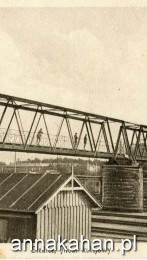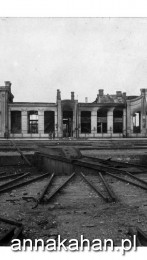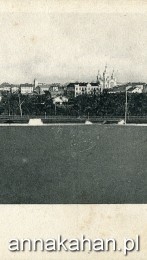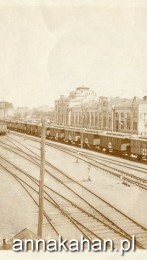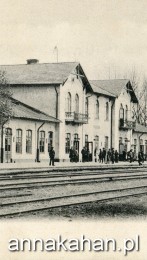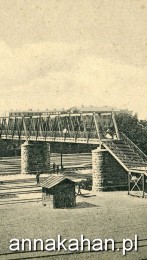[The Railway Station]
In Anna Kahan’s time, one could get to the railway station by taking a horse-drawn carriage from the west. This involved crossing Świętojańska Street, then going along the last section of Stodolna Street (currently 3 Maja Street) and turning left under the garwoliński viaduct between Vilnius and Warsaw tracks. Next, you would travel through a place once known as the “Monkey Grove” and the area where now is located the Siedlce 2 post office building.
In a place where today Zdanowski Square is located were once Vilnius railway tracks used by the trains arriving from Vilnius, Polotsk, Bologoye or Baranovichi. In addition, at that time, Armii Krajowej Street did not exist.
The first train arrived at the Siedlce station on October 10, 1866. Railway station building was then much smaller. Then in the years 1906 – 1908, a new Art Nouveau building, remembered by Anna Kahan, was erected. After the damages caused by the war in September 1939 and July 1944, it was not restored to its original form and beauty.
In addition, it is worth mentioning that the construction of the railway line from Prague to Siedlce took only a few months. The construction of a railway line linking Warsaw with Terespol started in May 1866, and in September, a segment between Warsaw and Siedlce was put into operation.
In her story My parents escaped two months after their wedding, Anna describes the train station.
“Siedlce had recently completed the building of a new train depot and it was a beauty. Many residents of the town would come just to look at the spacious, artistically decorated rooms and the high cellings, or have a snack at the big buffet, decorated with fresh flowers.
Hershkeh hired a droshke and took along his mother and Rachel to meet the train. Esther's train was scheduled to arrive in the evening and the depot was lit with numerous lamps inside and lanterns on the outside. It was fantastic sight.
A long whistle announced the coming of the train. Porters with baggage rushed with their passengers toward the tracks. Hershkeh felt a sudden pride observing the scene. Oh, his town was growing like a big city, not just a Shtetl! It is not just a Yatkowa Street!
Two more whistles and the train, puffing heavily appeared from the distance. Emitting a thick, black cloud of smoke, it slowed down and finally stopped.”
Anna associated this place with different situations. Once, her friend Szaja, told her that on Monday, May 10, 1915, the Cossacks beat up the Jews at the railway station. Soon, trains with refugees fleeing eastwards began to pass through Siedlce. Among them, there were Jews whom the residents of Siedlce provided with food.
The residents of Siedlce also began to evacuate the city. They fled from the approaching German troops. On August 6, 1915, Anna’s father took their luggage to the train station. On this day, the author of the diary wrote that her father,
“(…) telling us not to worry if he is late returning from the station. He’ll be back in time to take us to the train.
Suddenly, we hear cries: “A zeppelin!” We rush out. We cannot see him as he’s flying above the clouds. We hear the distant roar of motors and the boom of shots fired at him.”
On August 8, 1915, Anna Kahan, together with her family went to Pińsk. Because of the large number of people leaving Siedlce and the war damage, the railway station building deteriorated, which Anna describes,
“As we enter the large hall, I am shocked at the change in its appearance. I’ve seen it once before and at time it impressed me with its elegance and luxury. Where is the richly stacked buffet? The potted palms and the flowers are gone so is the long damask-covered table with the burning candles in silver candelabras. Empty walls, a dirty floor, smoke-filled room, crowded with weary, despairing people. Not much difference now between second and third class passengers. They’re all waiting for a train. They are all fearing the bombs that might drop on them tonight.”
The next time Anna was at the train station in Siedlce was on March 18, 1916. On that day, a German guard let her in. The building was destroyed after a fire caused by the Cossacks on the night of 11th to 12th of August 1915.
Those were different days. The Germans not only introduced an obligation for the residents to carry an identity card with a photograph but also made the transportation more difficult. As Szczepan Ciekot described it in his Memories,
“(...) how you could get to Warsaw at that time. If someone wanted to go, for example, from Siedlce, for any purpose, they had to apply to the military commander of the place. The fee was 5 rubles, but it had to be 5 rubles in gold. If you did not have them, you had to buy them somewhere, and then you could get a travel pass. Before leaving, you had to go to the district health office in order to be examined. If the potential passenger looked suspicious, he or she had to undress and undergo a medical examination including clothes and underwear. If you got the certificate of being healthy and “clean” which meant that no lice were found on the skin or clothing, and paid 5 rubles in gold, then you would get a limited travel pass to go to Warsaw or elsewhere. After arriving to Warsaw, you had to check in at the headquarters of the place, and before departure, you had to check out, otherwise you could not go.”

